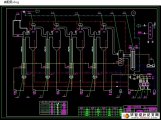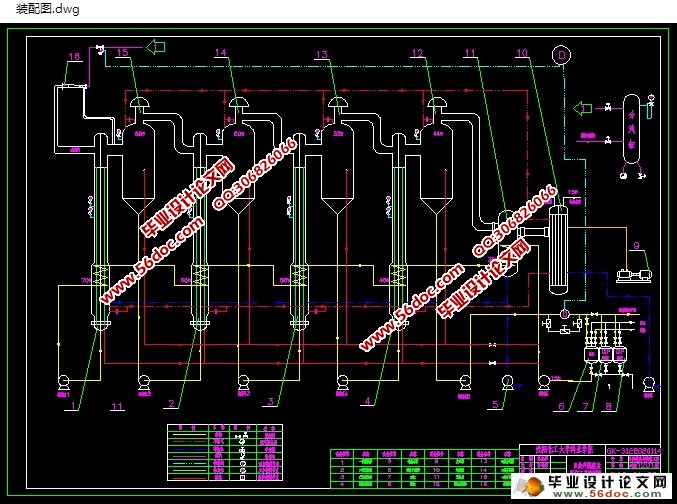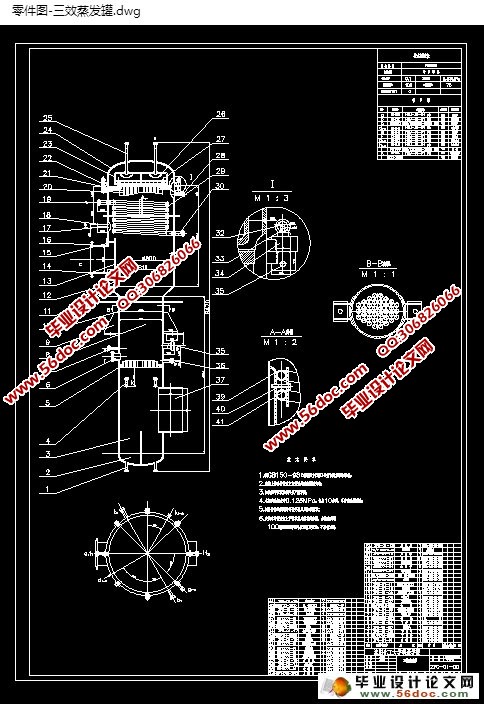中药厂水提液浓缩系统节能改造技术(蒸发水量4000kg/h)(含CAD图)(设计说明书12400字,CAD图纸4张)
摘要
随着人们生活水平的提高,越来越重视药物的使用,中药因其毒副作用小、适合养生而备受关注,中药的的品质也越来越受到大家的关注。采用升膜蒸发器来获取所需的中药成品,已成为当今中药成品的首选。本文是对采用升膜蒸发器系统的研究,主要是研究升膜蒸发器的设计。中药是中华民族五千年传统文化的瑰宝,是千百年医疗实践的结晶,也是世界优秀文化的精华。我国中药产业经过几十年的发展,已具有一定的规模和研发能力,在中药材、中药饮片和剂型等方面取得了一定的成绩。然而随着人们生活水平的不断提高,以及新的健康理念产生,国内市场对中药的需求量迅速增长,竞争力的加强,中药的发展面临着巨大的挑战和机遇。
本系统为四效升膜蒸发器,拥有四个蒸发器和分离器,药剂原液经过四个不同的蒸发器,蒸发温度低,部分二次蒸汽经喷射式热压泵重新吸入一效加热器,热量得到充分利用,蒸发温度相对较低。浓缩比大,升膜式蒸发,使粘度较大的料液容易流动蒸发,不容易结垢,浓缩时间短,浓缩比可达到1﹕5。本设备可以实现全自动化生产,智能化系统管理,符合GMP标准要求。升膜蒸发器适宜处理蒸发量较大,热敏性,粘度不大及易起沫的溶液,但不适于高粘度、有晶体析出和易结垢的溶液。在不同的蒸发器中达到相应的浓度,经过分离式分离,然后进入下一效升膜蒸发器,最后获得所需要的药剂浓度。升膜蒸发器的构成是液体根据虹吸泵的原理进入加热管加热,流入到分离器后液体与蒸汽分离开来,通过循环管流回到蒸发器,形成闭路循环,这种蒸发器又称外循环蒸发器。与升膜蒸发器结构基本相同,主要区别在于原料液是从加热室的底部进入,料液进入加热管后,受热沸腾迅速汽化;蒸汽在管内迅速上升,料液受到高速上升蒸汽的带动,沿管壁形成膜状上升,并继续蒸发。产生的蒸汽与液相共同进入蒸发器的分离室,汽液经充分分离,低温位的蒸汽经压缩机压缩,温度、压力提高,热焓增加,然后进入换热器冷凝,以充分利用蒸汽的潜热,液相则由分离室排出[1]。
本系统达到了预定药剂的浓度要求,生产效率较之前的降膜蒸发器有所提高,蒸发量也有所提高,升膜蒸发器适宜处理蒸发量较大,热敏性,粘度不大及易起沫的溶液,但不适于高粘度、有晶体析出和易结垢的溶液,采用升膜蒸发器,蒸发效率更高,加上PLC控制系统,浓度精度控制更加精确,有很大的使用价值,市场前景广阔,实现了自动化的生产[2]。
关键词: 四效升膜蒸发器; 中药; 蒸发效率; 浓度
Abstract
With the improvement of people's living standards, more and more emphasis on the use of drugs, traditional Chinese medicine because of its toxic side effects, and concern for the health and quality of Chinese medicine are increasingly being everyone's attention. Use rising film evaporator to obtain the desired end product of traditional Chinese medicine, Chinese medicine has become the first choice for the finished product. This article is the use of climbing film evaporator system research is to study the climbing film evaporator design. 5,000 years of Chinese medicine is a treasure of traditional culture, thousands of years of medical practice is the crystallization of the world's best is the essence of culture. Traditional Chinese medicine industry after decades of development, already has a certain scale and research and development capabilities, has made certain achievements in Chinese herbal medicine, Chinese medicine Pieces, and other aspects of the dosage form. However, with the continuous improvement of people's living standards, and the new concept of health production, the rapid growth of the domestic market demand for traditional Chinese medicine, strengthening the competitiveness of Chinese development is facing enormous challenges and opportunities.
The four effect rising film evaporator, with four evaporation and separators, pharmaceutical dope through four different evaporator, the temperature is low, the second part of the steam jet by pressing the suction pump to a heater efficiency, heat is fully utilized, the relatively low evaporation temperature. Concentration ratio, rising film evaporation, the viscosity of the liquid material flow easily evaporate, not easy to scale, concentration time is short, concentration ratio up to 1: 5. This equipment can be fully automated production, intelligent management system, in line with GMP standards. Rising film evaporator suitable for processing a large amount of evaporation, heat-sensitive, small and easy to frothing viscosity of the solution, but not suitable for high viscosity, there are crystal precipitation fouling and easy solution. To achieve the appropriate concentration in different evaporator after separation separation, then go to the next effect rising film evaporator, and finally obtain the desired concentration of the agent. Climbing film evaporator constituting the liquid into the heating tube pump according to the principles of the siphon, the liquid flows into the separator after the separated vapor, flows back through the circulation tube evaporator, to form a closed loop, which is also called outer evaporator circulation evaporator. And rising film evaporator structure is basically the same, the main difference is that the raw material liquid entering from the bottom of the heating chamber, feed liquid into the heating pipe, the heat boiling the rapid vaporization; steam rose rapidly in the tube, the material was being driven by high-speed ascending vapor along rising wall formed into a film, and evaporation was continued. Steam generated by the liquid phase separation of the common into the evaporator chamber sufficiently vapor-liquid separation, cryogenic bit vapor compressed by the compressor, temperature, pressure increased enthalpy increases and then condensed into the heat exchanger, to take advantage of steam latent heat, the liquid is discharged by the separation chamber.
The system has reached a predetermined concentration of the agent requirements, production efficiency falling film evaporator improved than before, evaporation also increased, rising film evaporator suitable for processing large amount of evaporation, not heat-sensitive, viscosity and easy to frothing solution, but not suitable for high viscosity, there are crystal precipitation fouling and easy solution, using the rising film evaporator, higher evaporation efficiency, coupled with PLC control system, the concentration of precision control more precise, there is great value, market prospects broad, automated production.
Key words: apo Four-effect rising film evaporator; traditional Chinese
medicine; Ev ration efficiency; Concentration
节能型中药厂中药水提取液蒸发系统设计,蒸发水量4000kg/h。技术参数;为中药浸出液初始温度为15℃,初始固形物含量为0.05%,浓缩终了固形物含量为35%。本设计采用的是多效蒸发,设计效数为四效,料液经预热器预热后,再通过各效盘管预热,最终达到超沸点进料。蒸发所需要的热量是通过热压泵将一效产生的二次蒸汽和锅炉的生蒸汽混合后得到。
目 录
第一章绪论 1
1.1 中药产业的发展现状 1
1.2 设计内容及采取方法 2
1.2.1 设计内容 2
1.2.2采取方法 2
第二章蒸发技术 4
2.1 蒸发技术 4
2.2 降膜蒸发器结构 5
2.3 降膜蒸发器的特点 5
第三章设计计算 7
3.1 物料衡算 7
3.1.1 热压泵的喷射系数 7
3.1.2 蒸发水量 7
3.2 热量衡算 8
3.2.1 一效蒸发罐的热量衡算 8
3.2.2 二效蒸发罐的热量衡算 9
3.2.3 三效蒸发罐的热量衡算 10
3.2.4 四效蒸发罐的热量衡算 11
3.2.4 总热量衡算 12
3.3 蒸发罐设计计算 13
3.3.1 各效蒸发罐设计 13
3.3.2 周边流量校核 15
3.3.3.蒸发罐筒体内径 17
3.3.4 蒸发罐壁厚校核 18
3.4 各效预热盘管的设计计算 23
3.4.1 一效预热盘管 23
3.4.2 二效预热盘管 25
3.4.3 三效预热盘管 26
3.4.4 四效预热盘管 27
3.4.4 筒体封头的设计 28
3.5 分离器直径和高度的设计 29
3.5.1 分离器直径 30
3.5.2 分离室高度 30
3.5.3 分离器壁厚设计 30
3.5.4 分离器封头的设计 31
3.6 热能压缩泵的设计 32
3.6.1 拉伐尔喷嘴的计算 33
3.6.2 泵体的基本尺寸 34
3.6.3 扩压室的设计计算 35
3.7 预热器的设计 36
3.8 冷凝器的设计 37
3.8.1 热量 38
3.8.2 冷凝器所需冷却的热量 38
3.8.3 冷凝器的结构设计 38
3.8.4 冷凝器封头 39
3.8.5 冷凝器壁厚校核 39
3.9 管路设计计算 39
3.9.1 蒸汽矩形管道设计 40
3.9.2 物料管设计 40
3.9.3 上、下不凝气管 41
3.9.4 冷凝水出口管 42
3.10 泵的设计与选择 42
3.10.1 离心泵的设计与选择 42
3.10.2 真空泵的选择与设计 43
3.11 CIP局部清洗系统 43
3.11.1 CIP系统的简介与应用 43
第四章安装前的准备要求与安装注意事项 45
参考文献 46
致 谢 47
|







